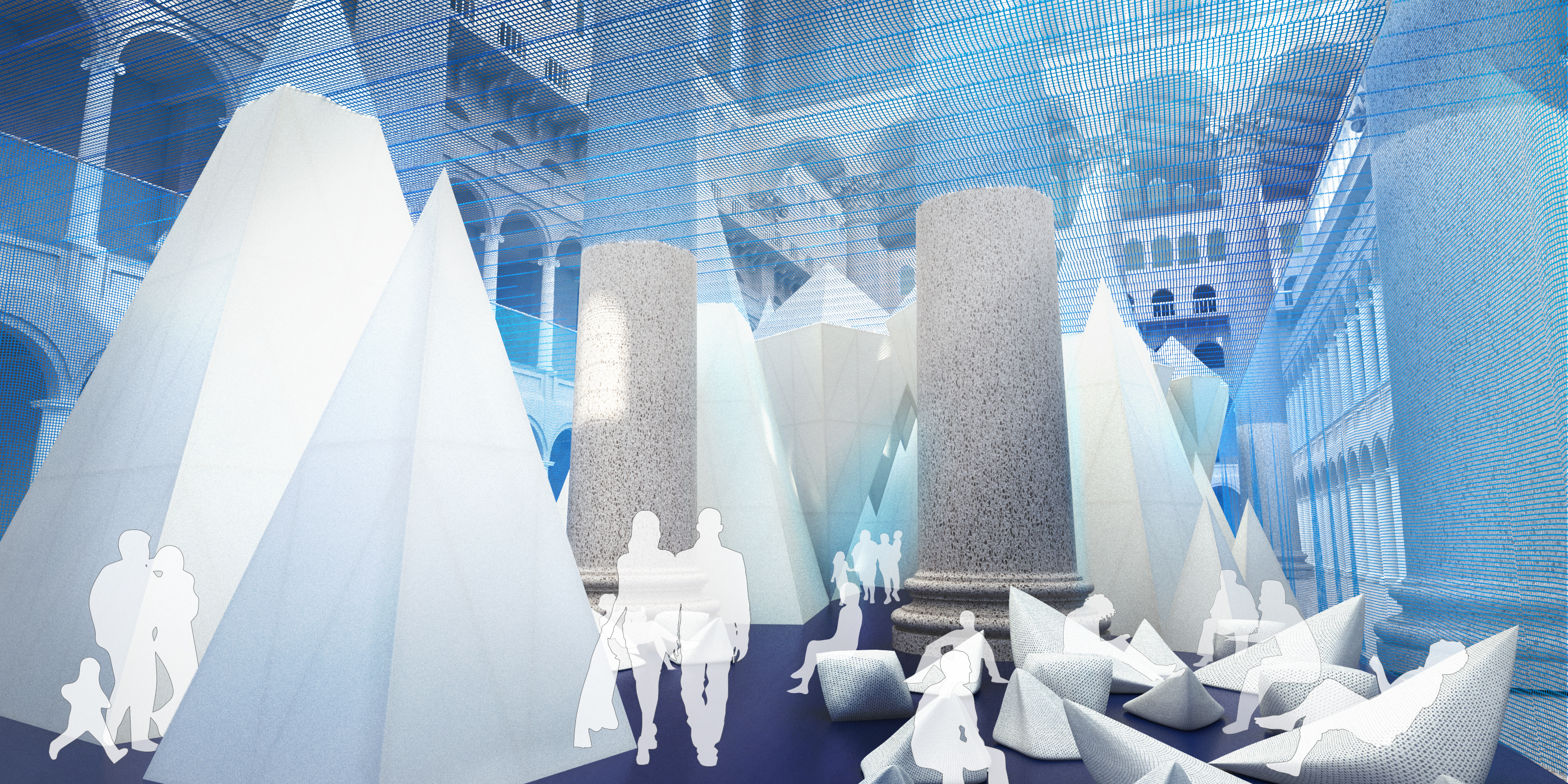It may have been an iceberg that sunk the Titanic, but in a ghastly new installation at the National Building Museum that opened July 2, it is “ICEBERGS” itself that fatally capsizes.
If you’re an adult with a hankering for shaved ice and a willingness to drop $16 for the privilege of eating it in an ugly blue “undersea” world, perhaps “ICEBERGS” is for you. If not, you’re better off just going to Rita’s and burning the change.
This exhibition, the latest in the National Building Museum’s relentless “Summer Block Party” series, attempts to transport visitors to an arctic ice field below the waterline and educate them about the horrors of climate change and the wonders of these mysterious, frozen elephants of the sea. Instead, it is a poorly executed show marred by intrusion of foreign substances that break what could have been — with the right artist and the right budget — a spectacular illusion.
The banal, blue mesh that surrounds the installation (a cavernous cube in the museum’s great hall) is littered with runs and piles forlornly at the hems, not to mention joining in horribly stitched vertical seams.
The bergs themselves are dotted with highly visible screwheads and their corners are lined with haphazardly applied clear packing tape bursting with air bubbles and creases.
The exposed corrugated plastic edges are simply messy, and by press preview day June 30, some apexes were already starting to fray.
The about 100 beanbags that will populate the show (in some inscrutable attempt to evoke ice shards with squishiness) are understuffed, and the entire exhibition smells not of polar coolness but of freshly-sawn wood.
That said, there are a few redeeming qualities. The down hanging “bergy bits” are intriguing, and the signature enormous crystal that ends the show and gives it a logo casts an imposing, grandiose, highly Instagram-able shadow.
The twin slides were a fan favorite even at the preview, much as the dirty metal carnival scaffolding that leads to them is ugly as anything.
The Daikaya restaurant kakigori shaved ice stand is sure to be a big hit, but the in-berg booth’s entire aesthetic — bodega food freezers, a solitary cooler, a random Japanese penguin poster and a menu sign that misspelled “condensed milk” — is just plain wrong.
It tries to be a crowd pleaser, but with ingredients like red bean, the palate it aims for is a little too sophisticated considering the other main attraction is literally a playground slide.
This has been the era of the museum phenomenon, from the Building Museum’s “BEACH” show (which drew 183,000 visitors, according to a museum curator) to the Renwick Gallery’s “WONDER,” which drew 700,000 per a Smithsonian American Art Museum news release. The Building Museum’s “Big Maze” drew 50,000 visitors, according to The Washington Post.
“ICEBERGS” attempts to follow in this legacy, but lacks any of the quality that made the other two shine. “BEACH,” with its panoply of plastic play balls, may have been a gimmick, but it was undeniably fun and by most accounts well-executed.
“WONDER” may have done more for Instagram than it did for the fine arts, but it was staggeringly beautiful — and did a hell of a lot for the fine arts anyway!
“ICEBERGS” is neither fun nor beautiful, and is executed so poorly as to the point of looking thrown together. It seems as though the summer show was hastily built from whatever Home Depot had in stock. It does comparatively little to spur visitors to action on climate change, and as one Facebook commenter pointed out, the creations themselves resemble actual bergs very little. None in the real world sit on the sea floor, and this along with other failings puts off any scientific redemption of the show.
This is in part so painful because the show’s idea is a good one that could have been done so much better by an institution with more concern for art and less concern for visitors and their pocketbooks.
All one foresees in the show’s summertime run are long lines for slides and shaved ice with slight, fought back disappointment on the Metro ride home — all, of course, at a $16 adult ticket price.
If “ICEBERGS” turns out half of “BEACH”‘s visitorship in adult ticketholders, it still stands to make more than $1 million past its $250,000 cost to build, as quoted by a museum curator — a hearty payday for one of Washington’s three main admission-charging museums.
Let’s deny them that windfall then, and send the clear message that District museumgoers cannot be bought with glitzy, all-caps logos and inspiring words alone.
Those help, surely, but like the horrid plastic ice shards of this horrendous installation, they need something (in this case, unpainted, splintering plywood) to hold them up.
Icebergs’ underwater foundations make up 90 percent of their total mass, but in “ICEBERGS”‘s case, there simply isn’t any foundation.
In fact, there isn’t any substance at all.
“ICEBERGS” runs at the National Building Museum, with adult admission price of $16, through Sept. 5.



